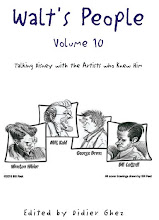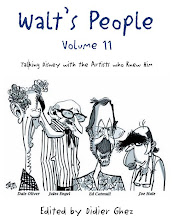Life in the Mouse House, the memoir of Golden Age Disney story artist Homer Brightman is now available on Amazon.
Homer Brightman was one of the members of Disney's Story Department from 1935 to 1950, right in the middle of the Golden Age of Disney animation.
During those fifteen years, he was often teamed up with other legendary story artist, Harry Reeves and was instrumental in developing dozens of storyboards for some of the most famous Disney shorts, many of them featuring Donald and Pluto. Among the classic shorts tackled by Brightman, we find
Alpine Climbers, The Fox Hunt, Clock Cleaners, Beach Picnic, The Fire Chief, and
Lend a Paw. Homer also worked on several of the features, including
Snow White, Pinocchio, Bambi, Saludos Amigos, The Three Caballeros, Make Mine Music, Fun and Fancy Free, Melody Time, The Adventures of Ichabod and Mr. Toad, and Cinderella.
Being part of the Story Department, Homer was at the very heart of the Disney Studio and worked with some of its stars, including Ted Sears, Dave Hand, Perce Pearce, Roy Williams, Carl Barks, Ham Luske, and Frenchy de Trémaudan.
After Disney, Brightman joined UPA, MGM, and Walter Lantz. He passed away in 1988.
Here is the introduction I wrote for the book:
[Most of the talented artists who knew and worked with Walt Disney are gone. Those who have never or seldom been interviewed took their precious memories to the grave.
Or did they?
Thankfully, for Disney History addicts like myself, there are still hidden autobiographies and memoirs to be unearthed: from the legendary 1938 – 1948 diaries of animator Ward Kimball, to the not-yet-released autobiography of concept artist Mel Shaw,
Animator of Horseback, or the recently discovered notes of Eric Larson for his book
50 Years in the Mouse House. Needless to say, those documents are extremely rare and of uppermost value to Disney historians and Disney enthusiasts alike. So when I found traces of a memoir written by a story artist of Disney’s Golden Age, in the archives of Disney historian Michael Barrier, I knew that I had hit “pay dirt.” The story artists worked closest to Walt than any of the other artists and they were at the center of the Studio’s creative process. The ‘30s were the most exciting creative period at the Studio. And Homer Brightman despite having collaborated to dozens of shorts and quite a few features, was one of the lesser known artists of that era. I knew that the book would be fascinating and enlightening.
After tracking down Homer’s daughters, Pamela Etzler and Connie Heller-Zeiger, and after reading the book, I was glad to confirm that its contents are indeed exhilarating from a Disney history standpoint.
There are dozens and dozens of stories in this volume which are either brand new or shed new light on what we already knew: hilarious memories of fellow story artists Harry Reeves, Perce Pearce, Roy Williams, Webb Smith and many others; new information about the career of animator Frenchy de Trémaudan; new details about the events of the 1941 Studio strike; and, almost at every page, new elements that help us “connect the dots” when it comes to artists and events. In other words, I learned something exciting and fun in each chapter.
But there is also a darker side to Homer Brightman’s memoir. One can feel that his fifteen years at the Studio were not a happy time professionally and emotionally. The man we discover is one who while at the Disney Studio suffered due to internal politics, constant fear of losing his job, and artistic frustrations. This unhappiness leads to a very dark portrait of Walt. We all know that Walt was not a saint and could be a harsh taskmaster. Many of Homer's colleagues, however, had a very different point of view on Walt as a boss and as a human being. Many of those positive perspectives are shared in the pages of the book series
Walt's People.
In other words, as it always is when reading an autobiography, it is important to keep in mind that Homer Brightman’s perspective is subjective. His point of view is nonetheless a very important one, his story fascinating, and his prose is so clear that his book, from day one, was a delight to read.
When he completed his book in 1986, Homer decided to hide the names of his co-workers behind pseudonyms. Homer’s daughters, Pam and Connie felt that the body of the book had to be released exactly as Homer had left it with the only addition of a few endnotes to clarify a few facts and the rare faulty memories. Thankfully both also realized that the book takes another dimension when one knows who are the artists hidden behind the pseudonyms. I am therefore enclosing below a list of the names of the individuals we believe we identified, thanks to notes left by Brightman as well as some additional research completed while working on this manuscript. I strongly encourage you to make reference to this list while reading Homer’s memoir.
Life in the Mouse House is an enlightening adventure, which for Homer ironically started on a grey morning of February 1935…]










































